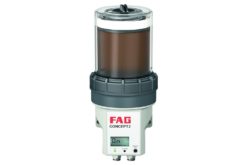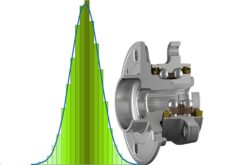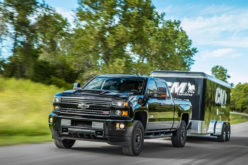Have you ever had a machine down because of a $1 bolt? Or perhaps you have needed a Torx Wrench #7, and the only one is in Joe’s toolbox, which is locked because he’s out? Or you have repaired something on a piece of cardboard on the floor (on your knees), because the tables are all busy? If these situations have ever happened to you, or if this is the normal reality in your shop, well… there are two solutions for you: embrace 5S, or treat your machine tool as if it was your car. The second choice sounds funnier, so let’s see where that brings us!
The Connection
You finally bought that Camaro ZL1, a beautiful, high performance car. Do you know what the most important component is? The tires! Tires connect the car to the road and the 580 horsepower from your new car needs to be released properly through the tires. The tires allow you to enjoy your car’s performance and the acceleration/deceleration G’s. What is the tire equivalent in machine tools? The toolholder! It connects the cutter to the machine. The holder allows the cutter to enjoy the machine’s power and rigidity. Unfortunately, the effects of a toolholder in poor condition can be very difficult to detect. For example, run-out has a big impact on the cutter and the spindle life, but it’s not easy to spot and many times is overlooked. Toolholders deserve the maximum care, and they should only be in two locations: in the machine, or in the toolholder storage with the mating surfaces protected. Every time a holder is removed from the machine, it must be cleaned, oiled, and put away.
The Flat Surfaces
If you think that a cart is a permanent storage on wheels and a table is a permanent storage not on wheels, let me tell you – you are wrong! What’s a pickup truck good for if its bed is always full of stuff? Normally the bed is empty, ready to be loaded at any moment and unloaded as soon as possible. Carts and tables in a machine shop make our life easier and they can only do their job if they are normally empty. Therefore, if you use a cart for whatever reason, when you are done the cart should be empty again, so the cycle can start over. For a table, use the 60/40 rule: 60% of the tabletop must be free and 40% is for the tools needed to perform the job. If you find yourself with less than 60% free area, you have a clutter problem. Clutter always has a negative effect on part quality.
The Clean
Air does not clean, it just moves the metal shavings somewhere else. This “somewhere else” means corners and hard-to-reach locations between moving parts. The result is more wear and tear on your machine tool. How does a car wash work? Water first, to take the dirt down to the floor where it goes in the drain and it can be easily removed. Then air for drying. The same should be done with machine tools: at the end of every day, with the wash gun, use the machine coolant to take the metal shavings from the machine or the part down to the chip conveyor, where they can easily be removed.
The Care
How do car makers make sure your engine and transmission stay at top performance? Scheduled maintenance performed by certified technician. Your machine tools have the same needs. There are oils and filters that have to be replaced periodically and there are inspection points to be checked. In addition, the leveling and the accuracy have to be checked periodically. A machine tool is made to work for many hours a day. Letting it go until something breaks just isn’t that smart.
The Cheap and the Right
So, you bought that very well kept used car for almost nothing. A deal, right? And now, your daily 30-mile commute to work is an adventure between the car breaking down and fixing stuff on the fly. Keep getting to work late and you may even lose your job. Basically, what you saved by buying a cheap used car goes to the repair shop and frustration. The same is true with machine tools, and actually, the machine shop is the perfect example of “you get what you pay for.” Replace “cheap” with “right” and you are going to be fine. Buy the right machine for your job not the cheaper one, and the right cutter not the cheaper one. In a machine shop, as with cars, it’s all about tomorrow, never about today. A cheap cutter that saves you few dollars today, will produce more scrap that will cost you many more dollars tomorrow, if not even a customer. (Please read Kyle Klaver’s blog post: The Shocking Truth About “Cost of Quality”)
The Knowledge
Have you noticed that if someone wants to work on a car it’s usually an old one? Yes, old cars are cool, but they’re also the ones that are understood and easy to play with. Today, cars are complicated. A lot of electronics and software is on top of the mechanics. It’s relatively easy to play with a carburetor, but it’s another story to play with an electronic injection. Metal cutting is not different – it’s a science and a complicated one. A successful part is the result of many factors: building floor quality, machine installation and general conditions, environmental temperature and humidity, part holding, cutters, toolholders, coolant, process and programming. Physics, mechanics, hydraulics, pneumatics, electronics, software, chemistry, and material science all are involved every single moment in metal cutting.
Intimidating, but true. Technically speaking, only engineers should be around machine tools! In fact, an engineering mindset is the foundation of successful machine shops.
If you still think it’s better to embrace 5S, I cannot disagree with you. Just remember that a machine tool is a “tool” for making parts. It’s like a brush in the hand of an artist: the best artists use the best tools that are kept in perfect condition!
 Germano Zerbini
Germano Zerbini
Germano has been in the manufacturing industry since 1990 and has extended experience in this field. Originally from Italy, he has a degree from B. Castelli Technical Institute in Brescia, Italy. Germano spent his first fourteen years as a CNC programmer and shop foreman with an Italian company, after which he moved to the United States. In subsequent positions he has worked as a machinist, programmer, engineering manager and plant manager. Germano joined Okuma in 2012 as an applications engineer, and his experience with solid modeling and programming multi-axis mills and lathes has made him a valuable asset to the team. Always looking to improve his skills, Germano enjoys working with complex and challenging parts.
This article first appeared as a blog post on March 4, 2015 on www.okuma.com
Image Courtesy: Chevrolet











